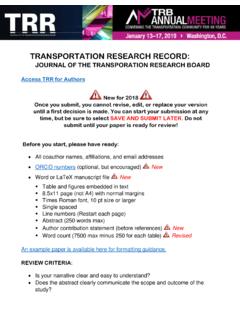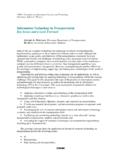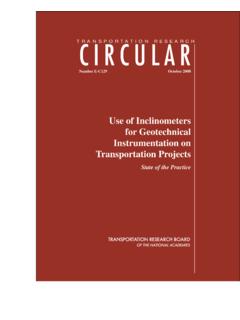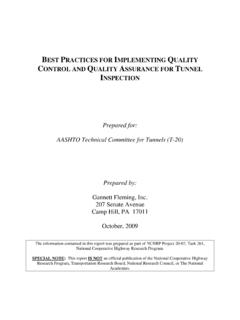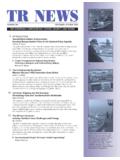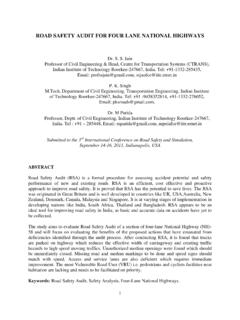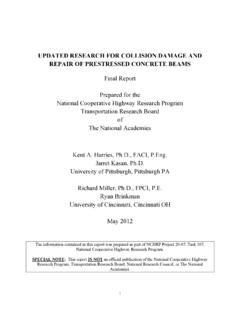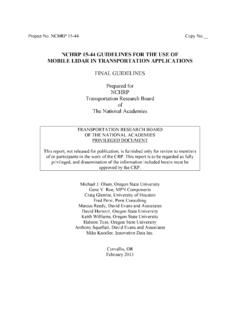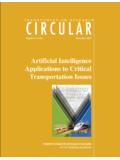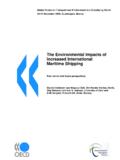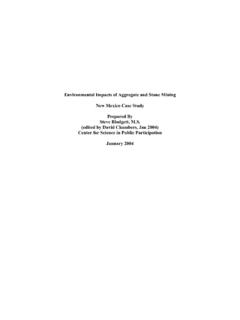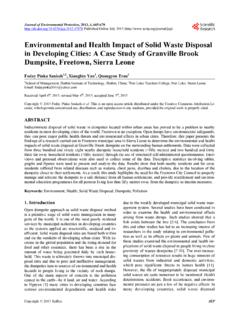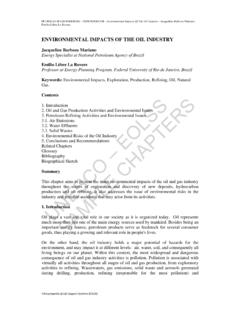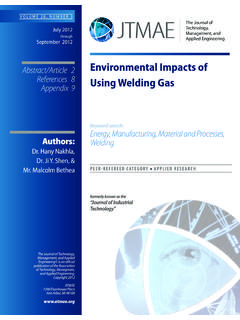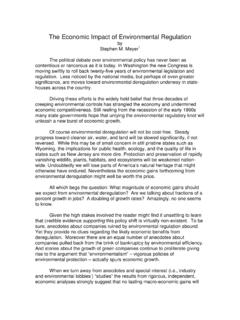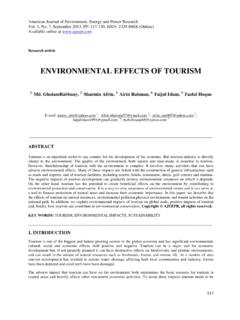Transcription of Environmental Impacts of Aviation
1 A1J52: Task Force on Environmental Impacts of AviationChairman: Dan Wormhoudt, Environmental Science AssociatesEnvironmental Impacts of AviationPETER J. GRAY-MULLEN, Edwards and Kelcey, Aviation is experiencing dramatic growth in regions throughout the world,including North America and the United States. However, airport development has not keptpace with increases in Aviation activity and the problem is now acute in the United States. In1996 the Federal Aviation Administration (FAA) Administrator identified lack of airportcapacity as the single most important constraint to realizing forecast rates of growththroughout the Aviation industry. Funding is one problem. The annual shortfall betweenfunds needed for airport development and total funds available is difficult to determine buthas been estimated at more than $4 billion annually in recent years. A second problem is therapid pace of change in Aviation technologies. Changes in the design and construction ofairfield and landside facilities will be necessary to accommodate the larger aircraft that willenter service and the new navigation and air traffic control systems that will be deployed inthe near planning approaches are essential to timely development of new airportfacilities, and Environmental documentation is a key component of the planning actions ( , funding, approvals) in connection with proposed airport developmentoften require Environmental review pursuant to the National Environmental Policy Act(NEPA) and the implementing guidelines of the Council on Environmental Quality and theFAA, which is in the process of updating its Airport Environmental Handbook ( ).
2 In addition to NEPA, a number of states have enacted statutes that mandateevaluation of the potentially significant Environmental Impacts of development, includingairport projects. Beyond compliance with NEPA and state Environmental review statutes,airport development proposals may trigger additional analytic requirements that must becarried out in parallel or sequential processes, for example, air quality assessments pursuantto the Environmental Protection Agency (EPA) General Conformity Rule and historicresource documentation pursuant to Section 106 of the National Historic Preservation Actof 1966. Environmental analyses for airport development projects are increasingly subject totechnical, political, and ultimately legal scrutiny. More and more often, challenges are raisedas to the adequacy of NEPA and state Environmental documents as well as studiessupporting related determinations by lead agencies or agencies with jurisdiction or is in this context that Environmental analysis for airport projects enters the newmillennium.
3 Within a year, the FAA plans to release the long-awaited update of theHandbook, Order , which likely will serve as the FAA s NEPA guidance for thenext 20 years. This paper anticipates and explores the years beyond 2025, the period inwhich the FAA may issue an as yet unknown , presumably the state-of-the-artTransportation in the New Millennium2 NEPA guidelines for the new millennium. Major Environmental assessment issues can besimplified by division into two categories: Operational Impacts those issues related to patterns of Aviation operational activityand thus driven by changes in aircraft design, airport capacity, and air traffic management;and Geographical Impacts those issues related to the size, dimension, and placement ofairport facilities that may result in effects on natural resources including wetlands,floodplains, flora, and paper covers the operational issues most likely to affect Environmental assessmentsin the new projects requiring federal action in 2025, one would expect that the primary processfor evaluating the Environmental Impacts of proposed airport development will continue tobe that specified in the current version of FAA Order 5050, the regulations of the Councilon Environmental Quality (CEQ), and other currently applicable NEPA documentation for airport development projects will continue to be preparedin the current forms, depending on the type of action proposed and its likely environmentaleffects: Environmental Assessments (EAs), Findings of No Significant impact (FONSI), Environmental impact Statements (EIS), and categorical exclusions.
4 However, the analyticmethodologies and the criteria for determining the significance of potential Impacts willchange as compared with today s state of the art. In other words, although the process maystay substantially the same, one would expect the criteria, tools, and threshold levels tochange the majority of cases, Environmental review pursuant to NEPA for airport projects willcontinue to begin with the preparation of an EA, which either will support a FONSI or, inthe event that the EA concludes that the action as proposed would result in significantimpacts, will require preparation of an EIS and issuance of a Record of Decision (ROD).Three major areas of the EA process that are expected to change are public participation,simplified review, and access to data. These changes will likely reduce the time and costrequired to complete the participation in the next millennium will benefit from improved means of reachingthe general public through media.
5 Use of the Internet, just beginning to reach the generalpublic, will expand and become the primary medium to convey project status, information,and working documents. Its widespread use will streamline coordination and review periodsbetween agencies and sponsors, as well as review by the general public. The Internet, withvideo and audio capabilities, will allow evaluators improved opportunities to understandalternatives that are not currently afforded by paper improvement anticipated in the EA process will be the use of checklists orforms to streamline the agency review process. Through the use of predetermined EAcategories or levels of review, the FAA, as lead agency for NEPA review, can focus effortson significant Environmental Impacts only, thereby reducing the time and cost required tomaneuver through the Environmental review process. This process could also be integratedwith the review processes of cooperating agencies and agencies with special expertise orEnvironmental Impacts of Aviation3jurisdiction.
6 On the basis of these improvements to the process, proponents, decisionmakers, and the public could expect consistent evaluations throughout the United in computer technology will have the greatest impact on improving the EAprocess and quality of the documentation. Computers and the Internet have allowedagencies to collect, store, and retrieve more Environmental data than ever before. This trendinto the next millennium will provide decision makers and the public, as well as projectproponents, with considerable historical data and also continuously updated projections (forexample, air passenger and air cargo demand forecasts). Computer technology will improvethe process largely through the manipulation and presentation of these data. Time-intensiveefforts to collect and inventory Environmental data will be improved through satellite andaerial imagery, Global Positioning System (GPS) tracking and survey, and AND NEEDD emand, capacity, and safety have been the primary reasons defining the purpose and needfor airport development for EAs.
7 Air travel demand has grown in the last 20 years million domestic enplanements in 1979 to million domestic enplanements,7,200 air carrier and commuter aircraft and 194,300 general Aviation (GA) aircraft, and 116million operations in 1998 and is projected to more than double by 2025 to 1, domestic enplanements. During the same period, the fleet is expected to growto 17,200 air carrier and commuter aircraft and 248,800 GA aircraft. Total air carrier,commuter, and GA operations are collectively projected to reach million by 2025. There is continued evidence to support the robust increases in thedemand forecasts for all types of Aviation . As noted in the introduction to this paper,existing infrastructure will continue to fall short of these levels of demand, therebynecessitating capacity enhancements and development to meet characterizes the analysis of alternatives capable of satisfying the purpose and needfor a proposed action as the heart of the Environmental impact statement.
8 Alternativesanalysis, including analysis of the proposed action, will continue to be the preferred methodfor decision makers and the public to compare and evaluate competing issues and potentialeffects on the quality of the human environment. One would expect improved computerprocessing, graphical presentations and media, prediction models, and access to historicaldata to enhance the evaluation of alternatives, consistent with the NEPA mandate to rigorously explore and objectively evaluate all reasonable alternatives. Under the premisethat air transport has provided significant public benefits over the last 50 years by providingjobs, economic prosperity, and increased trade and tourism, Aviation development willcontinue to compare alternatives involving economics, time (translated into costs), andsafety benefits with respect to minimized and mitigated Environmental ENVIRONMENTSome of the most significant changes anticipated for Environmental assessment will certainlybe the analysis, both quantitative and qualitative, of effects on the environment.
9 AlthoughEAs will continue to focus on the airport and its adjacent communities, developmentalimpacts will also be evaluated on regional, national, and international levels. Air transportTransportation in the New Millennium4has become an international industry and business. One could argue that it has become oneof the infrastructure systems necessary to the maintenance of a global economy. As thistrend continues, the potential to adversely affect the environment on a global scale will analysis and impact criteria will certainly undergo a profound change in the nextmillennium. Significant improvements in technology, in conjunction with regulatorymandates, have reduced noise Impacts steadily over the last 20 years. This downward trend,which is based on today s evaluation metrics, is expected to continue through , as the volume of operations continues to increase, so too will the overall noiseimpact and footprint. One would expect noise standards and models to change also.
10 Forexample, in response to public sensitivity, the National Park Service has already begunreview and consideration of new noise standards in wilderness there are concerns in the Environmental community that the modern high-bypass turbofan engine design, although quieter by Integrated Noise Model evaluations,may propagate other mechanical noise such as turbine whine. Could this mechanical noisetrigger new thresholds or metrics? Is it not possible that technology advances in the newmillennium may reach such limits that EAs will evaluate not engine noise output, but rathernoise resulting from the airframe traveling through the air? In many ways, airportdevelopment is victim to the current generation of public perception. Acceptable noiselevels 20 years ago would be unacceptable today. So will the case be 20 years into metrics will continue to play a key role in quantifying potential noise agencies, including FAA, the National Aeronautics and Space Administration(NASA), and the International Civil Aviation Organization (ICAO) will certainly requireand set new standards for noise metrics, modeling, and acceptable levels.
